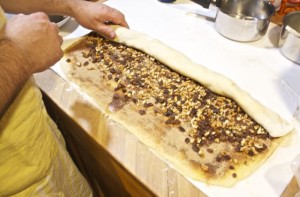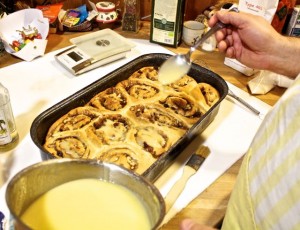Gestern hat Mathias Zimtschnecken gebacken. Sehr lecker, sehr gehaltvoll.
Zutaten
Hefeteig:
2 Pck. Trockenhefe
1 Tasse Wasser
180 g Butter
200 ml Milch
2 Eier
100 g Zucker
2 TL Salz
800 g Mehl
Füllung:
150 g Rosinen
etwas trockener Sherry
120 g Butter
200 g Walnüsse
200 g Zucker
4 EL Zimt (gemahlen)
Zuckerguß:
140 g Butter
150 g Puderzucker
150 g Vanille-Sirup (Monin)
Zubereitung
Hefeteig:
Hefe in lauwarmem Wasser mit 1 TL Zucker auflösen und gehen lassen. Butter mit Milch in einem Topf erwärmen, bis Butter schmilzt. Eier mit Zucker mischen, Butter und Milch zugeben, dann die Hefemischung, Salz und Mehl unterrühren. Alles zu einem weichen Hefeteig verkneten.
Schüssel zudecken und an einem warmen Ort gehen lassen (ca 90 Minuten).
Füllung vorbereiten:
Rosinen mit Sherry aufkochen. Butter in einem Topf schmelzen lassen. Eine große Auflaufform mit etwas Butter einfetten und mit etwas Zucker ausstreuen. Walnüsse zerbröseln. Zucker mit Zimt mischen.
 Schnecken herstellen:
Schnecken herstellen:
Hefeteig zu einem Rechteck von etwa 50 x 35 cm ausrollen.
 Mit geschmolzener Butter bestreichen, diese mit einem Pinsel verteilen. Zimt-Zucker darauf streuen, Rosinen und Nüsse darauf verteilen. Den Teig von der Längsseite her aufrollen.
Mit geschmolzener Butter bestreichen, diese mit einem Pinsel verteilen. Zimt-Zucker darauf streuen, Rosinen und Nüsse darauf verteilen. Den Teig von der Längsseite her aufrollen.
 Die Rolle in 12 Scheiben schneiden. Die 12 Schnecken in die Auflaufform legen, so daß die Spiralform oben sichtbar ist.
Die Rolle in 12 Scheiben schneiden. Die 12 Schnecken in die Auflaufform legen, so daß die Spiralform oben sichtbar ist.
Zugedeckt weitere 45 Minuten gehen lassen.
Anschließend im vorgeheizten Ofen bei 150°C für ca 25 – 30 Minuten hellbraun backen, bis sie durch sind (Garprobe mit Holzstäbchen).
Zuckerguß:
Butter in einem Topf schmelzen. Mit Puderzucker und Vanille-Sirup verrühren. Die Mischung mit einem Löffel über die Schnecken in der Form verteilen. Etwas abkühlen lassen.
Guten Appetit!
Die Schnecken schmecken frisch noch warm am besten, lassen sich aber auch hervorragend einfrieren. In diesem Fall kann man sie vor dem Verzehr mit der Mikrowelle aufwärmen.


